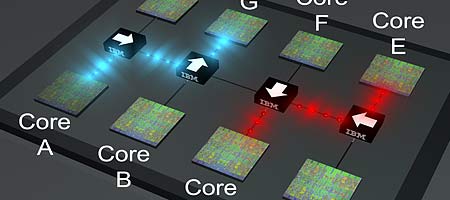IBM Envisions On-chip Optical Network For Future Processors
Yorktown Heights (NY) - IBM said it has developed a silicon broadband optical switch, a key component for the creation of on-chip optical interconnects: The company believes that nanophotonic switches will lead the way to CPU cares that communicate faster with each other while using much less energy.
According to IBM, the device is the smallest of its kind developed so far, representing a footprint that is 100 times smaller than a human hair. About 2000 of these switches would fit side-by-side into an area of 1 mm2, making it small enough to be integrated in future multi-core processors, the manufacturer said.
Photonic switches could become very interesting as the number of cores in processors increases. Not only are these devices expected to provide more bandwidth (IBM is talking about as much as 1 Tb/s), they could also be a critical piece to keep power consumption in check: Copper wiring between dozens of processor cores could mean that power consumption will be increasing down the road: Information that is transmitted via pulses in silicon instead of electrical signals on copper wires, could be much more power efficient, IBM believes.
"It is envisioned that using light instead of wires, as much as 100 times more information can be sent between cores, while using 10 times less power and consequently generating less heat," IBM said.
While optical switches have been demonstrated for some time, IBM said that its optical switch is the first capable of operating within a "realistic on-chip environment". The company claims that the chip remains operable in the vicinity of so-called hot-spots, areas where the temperature can change dramatically within short periods of time. IBM said that temperature-drift tolerant operation will be one of the most critical requirements for on-chip optical networks in the future.
Get Tom's Hardware's best news and in-depth reviews, straight to your inbox.

Wolfgang Gruener is an experienced professional in digital strategy and content, specializing in web strategy, content architecture, user experience, and applying AI in content operations within the insurtech industry. His previous roles include Director, Digital Strategy and Content Experience at American Eagle, Managing Editor at TG Daily, and contributing to publications like Tom's Guide and Tom's Hardware.
